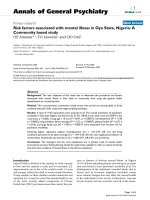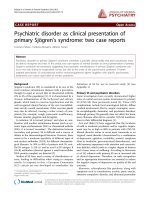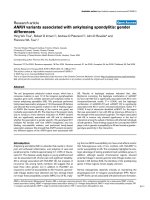Báo cáo y học: "Bromocriptine treatment associated with recovery from peripartum cardiomyopathy in siblings: two case reports" ppsx
Bạn đang xem bản rút gọn của tài liệu. Xem và tải ngay bản đầy đủ của tài liệu tại đây (453.91 KB, 4 trang )
JOURNAL OF MEDICAL
CASE REPORTS
Meyer et al. Journal of Medical Case Reports 2010, 4:80
/>Open Access
CASE REPORT
© 2010 Meyer et al; licensee BioMed Central Ltd. This is an Open Access article distributed under the terms of the Creative Commons
Attribution License ( which permits unrestricted use, distribution, and reproduction in
any medium, provided the original work is properly cited.
Case report
Bromocriptine treatment associated with recovery
from peripartum cardiomyopathy in siblings: two
case reports
Gerd Peter Meyer*
1
, Saida Labidi*
1
, Edith Podewski
1
, Karen Sliwa
2
, Helmut Drexler
1
and Denise Hilfiker-Kleiner*
1
Abstract
Introduction: Peripartum cardiomyopathy is a rare form of cardiomyopathy, with heterogeneous presentation
occurring in women between one-month antepartum and six months postpartum. It carries a poor prognosis and a
high risk of mortality.
Case presentation: We report the development of peripartum cardiomyopathy in two sisters, 27- and 35-year-old
African women, one of whom presented with a large left ventricular thrombus. Subsequently, both patients were
treated with bromocriptine, heparin and standard therapy for heart failure (angiotensin converting enzyme inhibitors,
beta-blockers and diuretics). During follow-up, the left ventricular thrombus observed in one patient degraded. Neither
patient experienced a thrombotic event, and both experienced continuous improvements in cardiac function and
New York Heart Association stage.
Conclusion: The development of peripartum cardiomyopathy in two sisters indicates that there may be a genetic
basis for this type of cardiomyopathy, and that women with a positive family history for peripartum cardiomyopathy
may have an increased risk of developing the disease. This is also the first report of a patient experiencing degradation
of a large left ventricular thrombus under standard therapy for heart failure with bromocriptine. It suggests that the use
of bromocriptine in association with adequate anti-coagulation and heart failure therapy may be beneficial and safe.
Introduction
Peripartum cardiomyopathy is a distinct entity of dilated
cardiomyopathy, and occurs in women between one month
antepartum and six months postpartum. Specific risk fac-
tors for peripartum cardiomyopathy have not been defined
and reports in the literature regarding positive family histo-
ries of peripartum cardiomyopathy are rare [1]. However,
the higher incidence of peripartum cardiomyopathy in cer-
tain geographic areas, specifically Africa and Haiti, indi-
cates a possible genetic factor [2].
At present, peripartum cardiomyopathy is treated accord-
ing to the guidelines for dilated cardiomyopathy with
angiotensin converting enzyme (ACE) inhibitors, beta-
blockers and diuretics (standard therapy for heart failure)
[2]. Nevertheless, the prognosis is poor, with reported mor-
tality rates up to 15% and full recovery in only 23% of
patients, while continuous deterioration is reported in up to
50% of patients despite optimal medical treatment [2-4].
Recently, oxidative stress-mediated generation of anti-
angiogenic and pro-apoptotic 16 kDa prolactin and subse-
quent impaired cardiac microvascularisation have been
related to peripartum cardiomyopathy [5]. A small pilot
study suggested that prolactin blockade by bromocriptine in
addition to standard therapy prevents repeated episodes of
peripartum cardiomyopathy in patients presenting with a
subsequent pregnancy [5]. Following this study, recent case
reports have suggested that bromocriptine may also be ben-
eficial in acute peripartum cardiomyopathy [6-8]. A survey
of more than 1400 pregnant women who took bromocrip-
tine primarily during the first few weeks of pregnancy
found no evidence of increased rates of spontaneous abor-
tion or congenital malformations [9]. However, safety
issues were raised for patients taking bromocriptine in the
early postpartum phase: a few case reports describe an
increased risk of thrombotic events, such as myocardial
* Correspondence: , ,
Department of Cardiology and Angiology, MHH, Carl Neuberg Strasse 1, 30625
Hannover, Germany
Meyer et al. Journal of Medical Case Reports 2010, 4:80
/>Page 2 of 4
infarction and retinal vein occlusion, in these patients [10-
12].
Case presentation
Case report 1
A 35-year-old African woman was admitted to our clinic
four weeks after an elective caesarean section with chest
pain, dyspnea, dry cough and New York Heart Association
(NYHA) functional class IV. It was her third pregnancy and
she had three healthy children. Her body mass index was
44. She had no pre-existing cardiac disease or exposure to
cardiotoxic agents. Because of elevated D-dimer levels
(15,44 μg/l) she was sent for computed tomography scans
of her chest, which confirmed a suspected pulmonary
embolism. The patient was therefore treated with the low-
molecular-weight heparin (LMWH) enoxaparin in a thera-
peutic dose (0.1 ml/10 kg KG), before being switched to
Coumadin (warfarin) (target international normalized ratio
[INR] 2.5). Echocardiography revealed severe left ventricu-
lar dysfunction with an ejection fraction (left ventricular
ejection fraction in percent; LV-EF) of 9%, left ventricular
dilatation (left ventricular end diastolic diameter [LVEDD]
63 mm) and a thrombus of 37 × 23 mm (Figure 1). Peripar-
tum cardiomyopathy was diagnosed, whereupon standard
heart failure therapy was initiated; the patient was also
treated with bromocriptine (5 mg/d for two weeks). Her
blood work showed that 76 amino acid N-terminal fragment
of Brain natriuretic peptide (NT-proBNP) (8084 ng/l) and
C-reactive protein (CRP) (60 g/l) were markedly elevated,
Serum creatinine (102 umol/l) and Troponin T (TNT) (0.05
μg/l) were mildly elevated, and creatine kinase (CK) (59 U/
l) was within normal range. Echocardiogram (ECG)
showed sinus tachycardia (heart rate 115 beats/min) and no
abnormalities indicative of repolarisation. Cardiac magnetic
resonance imaging (MRI), taken 7 days after the ECG, con-
firmed left ventricular enlargement and severely impaired
systolic left ventricular function (LV-EF 20%). It also
revealed pericardial and pleural effusions. After three
weeks, her left ventricular function and heart failure symp-
toms improved, accompanied by a decrease of NT-proBNP
concentrations (1757 ng/l) and a decrease in size of the left
ventricular thrombus (6 × 9 mm). During follow-up ECGs,
the thrombus was no longer apparent (Figure 1). The
patient was treated with bromocriptine (2.5 mg/d) for six
weeks in total, while standard heart failure therapy plus
Coumadin (warfarin) was continued for six months. After
six months, left ventricular function had further improved
(ECG indicated LV-EF 38%; MRI indicated LV-EF 45%),
with regression of the pleural and pericardial effusions. Her
NHYA class improved from IV to II, and her NT-proBNP
serum level decreased to 261 ng/l.
Figure 1 Four-chamber view on initial echocardiogram demonstrates a large thrombus (arrow) attached to the lateral wall of the left ven-
tricle (LV) at baseline (A), which has completely resolved after two months (B).
Meyer et al. Journal of Medical Case Reports 2010, 4:80
/>Page 3 of 4
Case report 2
The sister of our original patient, aged 27, presented during
her second pregnancy after developing peripartum cardio-
myopathy. She had previously given birth to one healthy
child via elective caesarean section, and had a body-mass
index (BMI) of 30.4. Caesarean section was indicated due
to imminent fetal asphyxia and amniotic infection syn-
drome. ECG revealed severe left ventricular dysfunction
with an LV-EF of 32%, slight left ventricular dilatation
(LVEDD 60 mm) and mild mitral regurgitation, but no
pathological signs. NT-proBNP (7397 ng/l) and CRP (219
g/l) were markedly increased, serum creatinine (88 umol/l)
and TNT (0,05 μg/l) were mildly elevated, and CK (29 U/l)
was within normal range. Treatment with standard heart
failure therapy, a half-therapeutic dose of enoxaparin (0.4
ml/d) for eight weeks and bromocriptine (5 mg/d for two
weeks, then 2.5 mg/d for six weeks) was initiated. Eight
months later, our patient had improved cardiac function
(ECG LV-EF 47%; MRI LV-EF 59%), normal left ventricu-
lar dimensions and NT-proBNP (142 ng/l) within normal
range.
Discussion
Intraventricular thrombi diagnosed by ECG are not unusual
in patients with peripartum cardiomyopathy [13]. It should
be noted that there is generally an increased risk for throm-
botic complications in peripartum women due to changes in
coagulation activity in maternal blood characterized by ele-
vation of factors VII, X and VIII, fibrinogen, and von
Willebrand factor, which is maximal around term [14]. In
peripartum cardiomyopathy patients with impaired cardiac
function, the risk of thrombotic events is further increased.
Our patient in case 1 presented with pulmonary embolism,
acute heart failure and a large left ventricular thrombus at
baseline. Upon initiation of standard therapy for heart fail-
ure together with heparin/Coumadin (warfarin) and bro-
mocriptine, our patient steadily improved and the left
ventricular-thrombus degraded without thrombotic compli-
cations. Our patient in case 2 was given low dose heparin
during bromocriptine treatment and recovered fully without
any adverse events. In fact, we have never observed throm-
botic events in peripartum cardiomyopathy patients treated
with bromocriptine and heparin [7] (this has also been con-
firmed by co-author Karen Sliwa in her unpublished obser-
vations of more than 30 peripartum cardiomyopathy
patients). Bromocriptine treatment, in combination with
heparin, appears not to increase the risk of thrombotic
events in peripartum cardiomyopathy patients. Moreover,
cardiac function and NYHA stage steadily improved in
both of our patients, suggesting that bromocriptine with
appropriate anti-thrombotic therapy is safe even in peripar-
tum cardiomyopathy patients with manifested thrombosis at
baseline.
While the risk of ventricular thrombi in peripartum cardi-
omyopathy seems more associated with the degree of car-
diac dysfunction, the observation that bromocriptine was
effective in both patients points to a similar pathophysiol-
ogy of the disease in both sisters. Reports of peripartum
cardiomyopathy with positive family history are rare [1].
However, the higher incidence of peripartum cardiomyopa-
thy in women with African ancestry suggests the presence
of genetic risk factors. In this case report, we present peri-
partum cardiomyopathy in two sisters whose genetic his-
tory - a Caucasian mother with no history of peripartum
cardiomyopathy and an African father - suggest a possible
genetic predisposition to peripartum cardiomyopathy in
women of African ancestry.
Conclusion
Our case report suggests that bromocriptine with appropri-
ate anti-thrombotic therapy is safe and beneficial even in
peripartum cardiomyopathy patients with manifested
thrombosis at baseline. Furthermore, the development of
peripartum cardiomyopathy in two sisters suggests that
women with a positive family history of peripartum cardio-
myopathy might be at a higher risk for developing the dis-
ease. Pregnant women with peripartum cardiomyopathy
should be monitored carefully for cardiac abnormalities
during pregnancy and peripartum.
Consent
Written informed consent was obtained from both patients
for publication of this case report and accompanying
images. A copy of the written consent is available for
review by the Editor-in-Chief of this journal.
Competing interests
The authors declare that they have no competing interests.
Authors' contributions
GP performed MRI and data analysis, and contributed to the manuscript. SL
performed data collection analysis. EP performed ECGs and monitored our
patients. SK contributed to the manuscript. HD is chief of the Department of
Cardiology and Angiology and supervised care of the patients and contributed
to the manuscript. DH managed and organized data achievement and registry
and contributed to the manuscript. All authors have read and approved the
final manuscript.
Author Details
1
Department of Cardiology and Angiology, MHH, Carl Neuberg Strasse 1,
30625 Hannover, Germany and
2
Soweto Cardiovascular Research Unit, Chris-
Hani-Baragwanath Hospital, University of the Witwatersrand, Old Potch Road
100, 2013 Soweto, Johannesburg, South Africa
References
1. Fett JD, Sundstrom BJ, Etta King M, Ansari AA: Mother-daughter
peripartum cardiomyopathy. Int J Cardiol 2002, 86:331-332.
2. Sliwa K, Fett J, Elkayam U: Peripartum cardiomyopathy. Lancet 2006,
368:687-693.
Received: 4 November 2009 Accepted: 4 March 2010
Published: 4 March 2010
This article is available from: 2010 Meyer et al; licensee BioMed Central Ltd. This is an Open Access article distributed under the terms of the Creative Commons Attribution License ( which permits unrestricted use, distribution, and reproduction in any medium, provided the original work is properly cited.Journal of Medical Case Repo rts 2010, 4:80
Meyer et al. Journal of Medical Case Reports 2010, 4:80
/>Page 4 of 4
3. Brar SS, Khan SS, Sandhu GK, Jorgensen M, Parikh N, Hsu J, Shen A:
Incidence, mortality, and racial differences in peripartum
cardiomyopathy. Am J Cardiol 2007, 100:302-304.
4. Elkayam U, Akhter MW, Singh H, Khan S, Bitar F, Hameed A, Shotan A:
Pregnancy-associated cardiomyopathy: clinical characteristics and a
comparison between early and late presentation. Circulation 2005,
111:2050-2055.
5. Hilfiker-Kleiner D, Kaminski K, Podewski E, et al.: A Cathepsin D-Cleaved
16 kDa Form of Prolactin Mediates Postpartum Cardiomyopathy. Cell
2007, 128:589-600.
6. Habedank D, Kuhnle Y, Elgeti T, Dudenhausen J, Haverkamp W, Dietz R:
Recovery from peripartum cardiomyopathy after treatment with
Bromocriptine. Eur J Heart Fail 2008, 10(11):1149-1151.
7. Hilfiker-Kleiner D, Meyer GP, Schieffer E, et al.: Recovery from postpartum
cardiomyopathy in 2 patients by blocking prolactin release with
Bromocriptine. J Am Coll Cardiol 2007, 50:2354-2355.
8. Jahns BG, Stein W, Hilfiker-Kleiner D, Pieske B, Emons G: Peripartum
cardiomyopathy a new treatment option by inhibition of prolactin
secretion. Am J Obstet Gynecol 2008, 199:e5-6.
9. Turkalj I, Braun P, Krupp P: Surveillance of Bromocriptine in pregnancy.
JAMA 1982, 247:1589-1591.
10. Hopp L, Haider B, Iffy L: Myocardial infarction postpartum in patients
taking Bromocriptine for the prevention of breast engorgement.
International Journal of Cardiology 1996, 57:227-232.
11. Loewe C, Dragovic LJ: Acute coronary artery thrombosis in a
postpartum woman receiving Bromocriptine. Am J Forensic Med Pathol
1998, 19:258-260.
12. Nagaki Y, Hayasaka S, Hiraki S, Yamada Y: Central retinal vein occlusion in
a woman receiving Bromocriptine. Ophthalmologica 1997, 211:397-398.
13. Sliwa K, Skudicky D, Bergemann A, Candy G, Puren A, Sareli P: Peripartum
cardiomyopathy: analysis of clinical outcome, left ventricular function,
plasma levels of cytokines and Fas/APO-1. J Am Coll Cardiol 2000,
35:701-705.
14. Brenner B: Haemostatic changes in pregnancy. Thromb Res 2004,
114:409-414.
doi: 10.1186/1752-1947-4-80
Cite this article as: Meyer et al., Bromocriptine treatment associated with
recovery from peripartum cardiomyopathy in siblings: two case reports Jour-
nal of Medical Case Reports 2010, 4:80









